
English Encyclopedia
 Architecture
Architecture

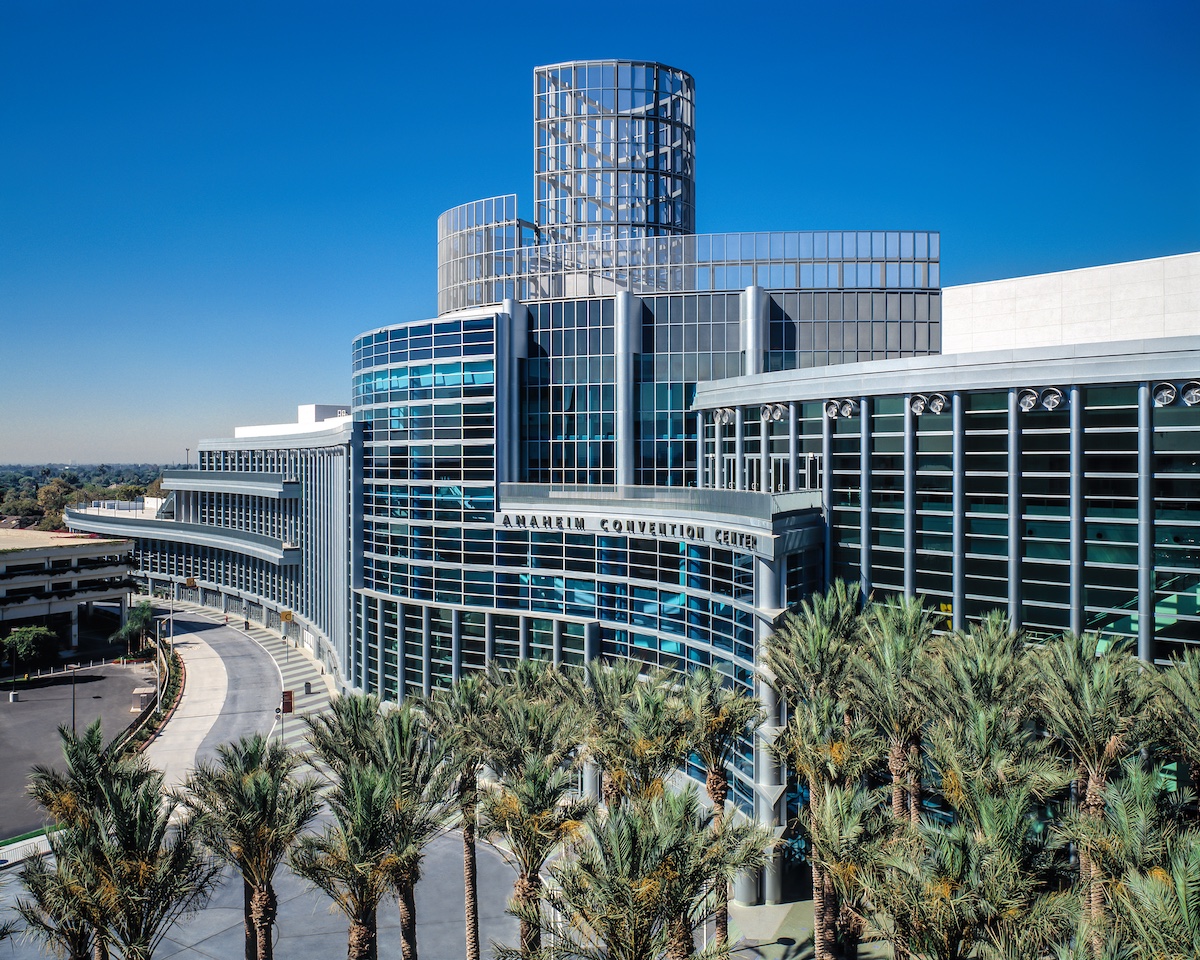
The Anaheim Convention Center is a major convention center in Anaheim, California and is the largest exhibition facility on the west coast. It is located across from the Disneyland Resort on Katella Avenue. The original components, designed by Adrian Wilson & Associates and built by Del E. Webb Corporation,[2] opened in July 1967—including a basketball arena followed shortly by the convention hall. It holds many events, like VidCon, BlizzCon, Anime Expo, D23 Expo, WonderCon, NAMM Show, competitions, and more. In addition to hosting various types of conventions, the Anaheim Convention Center was used to host the wrestling during the 1984 Summer Olympics.[3]
The center has subsequently undergone six major expansions (1974, 1982, 1990, 1993, 1999–2000, 2016–2017). It is the largest exhibit facility on the West Coast.
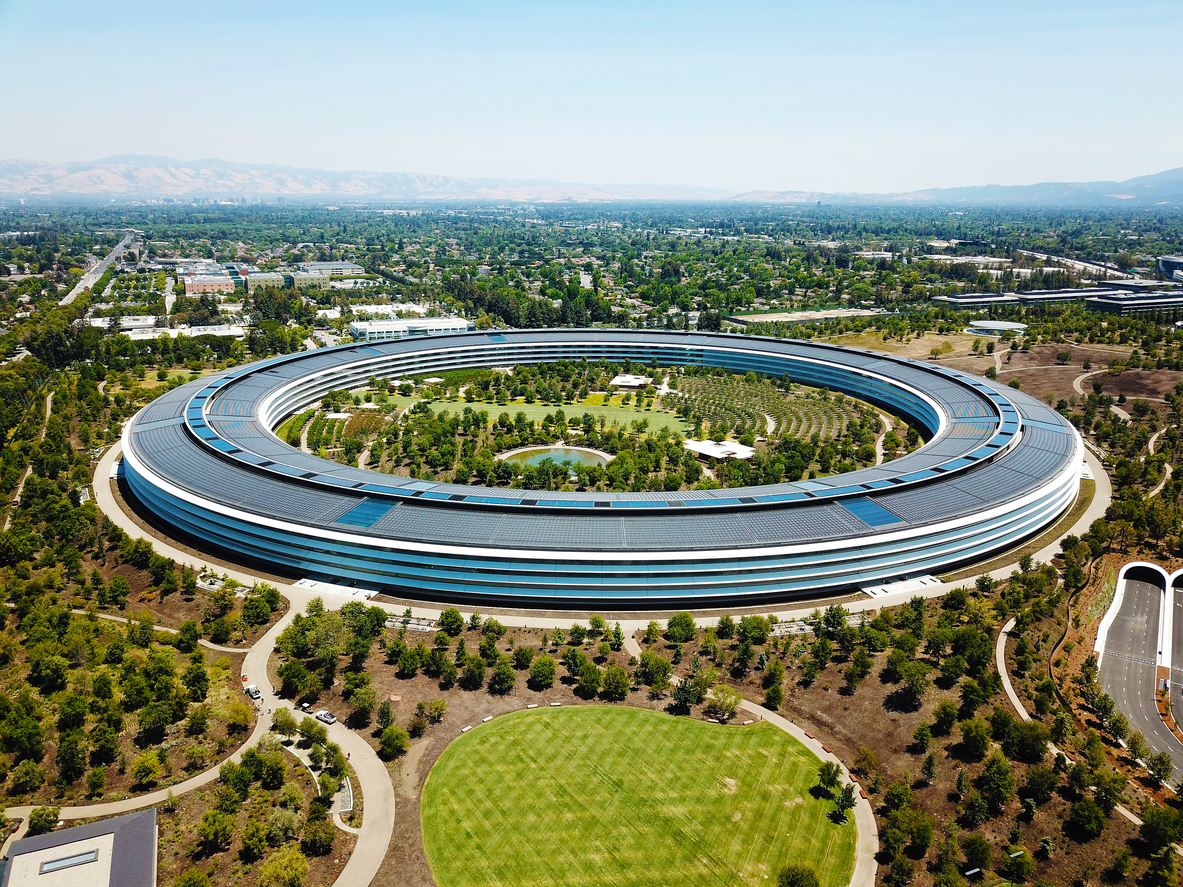
Apple Park is the corporate headquarters of Apple Inc., located in Cupertino, California, United States. It was opened to employees in April 2017, while construction was still underway, and superseded the original headquarters at 1 Infinite Loop, which opened in 1993.[7]
The main building's scale and circular groundscraper design, by Norman Foster,[8] have earned the structure the media nickname "the spaceship."[9][10][11] Located on a suburban site totaling 1.46 km2 (360 acres), it houses more than 12,000 employees in one central four-story circular building of approximately 0.26 km2 (64 acres). Apple co-founder Steve Jobs wanted the campus to look less like a business park and more like a nature refuge; 80 percent of the site consists of green space planted with drought-resistant trees and plants indigenous to the Cupertino area, and the center courtyard of the main building features an artificial pond.
Apple Park is located 1.2 miles (1.9 km) east of the original Apple Campus. Apple has had a presence in Cupertino since 1977, which is why the company decided to build in the area rather than move to a cheaper, distant location. The campus is also next to a contaminated site under Superfund legislation with a groundwater plume.
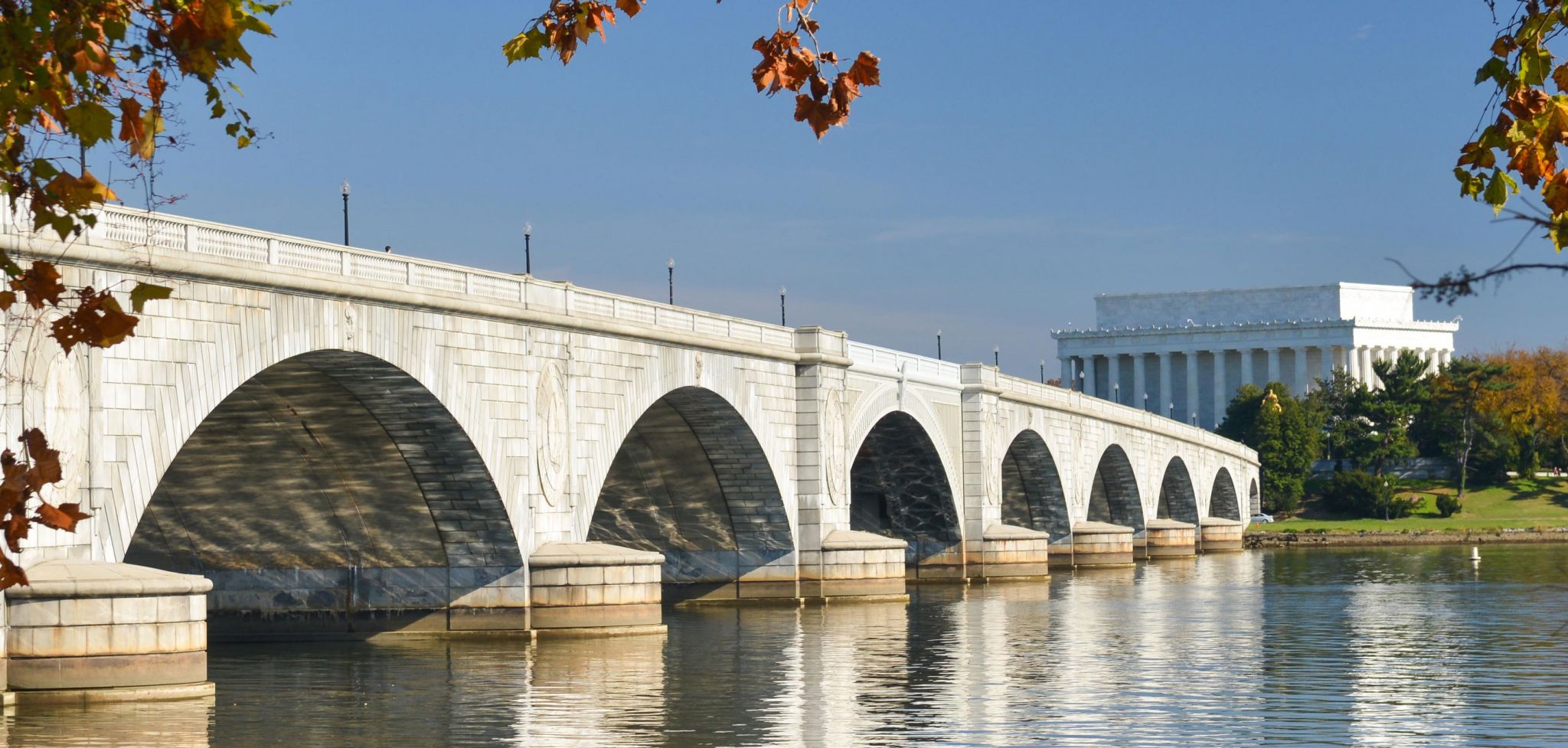
The Arlington Memorial Bridge is a Neoclassical masonry, steel, and stone arch bridge with a central bascule (or drawbridge) that crosses the Potomac River at Washington, D.C., the capital of the United States. First proposed in 1886, the bridge went unbuilt for decades thanks to political quarrels over whether the bridge should be a memorial, and to whom or what. Traffic problems associated with the dedication of the Tomb of the Unknown Soldier in November 1921 and the desire to build a bridge in time for the bicentennial of the birth of George Washington led to its construction in 1932.
Designed by the architectural firm McKim, Mead, and White, decorated with monumental statues depicting valor and sacrifice by sculptor Leo Friedlander, cast by Ferdinando Marinelli Artistic Foundry, Florence, Italy, Arlington Memorial Bridge defines the western end of the National Mall. The bridge's draw span was permanently closed in 1961 and replaced in 2018 by one that does not open.
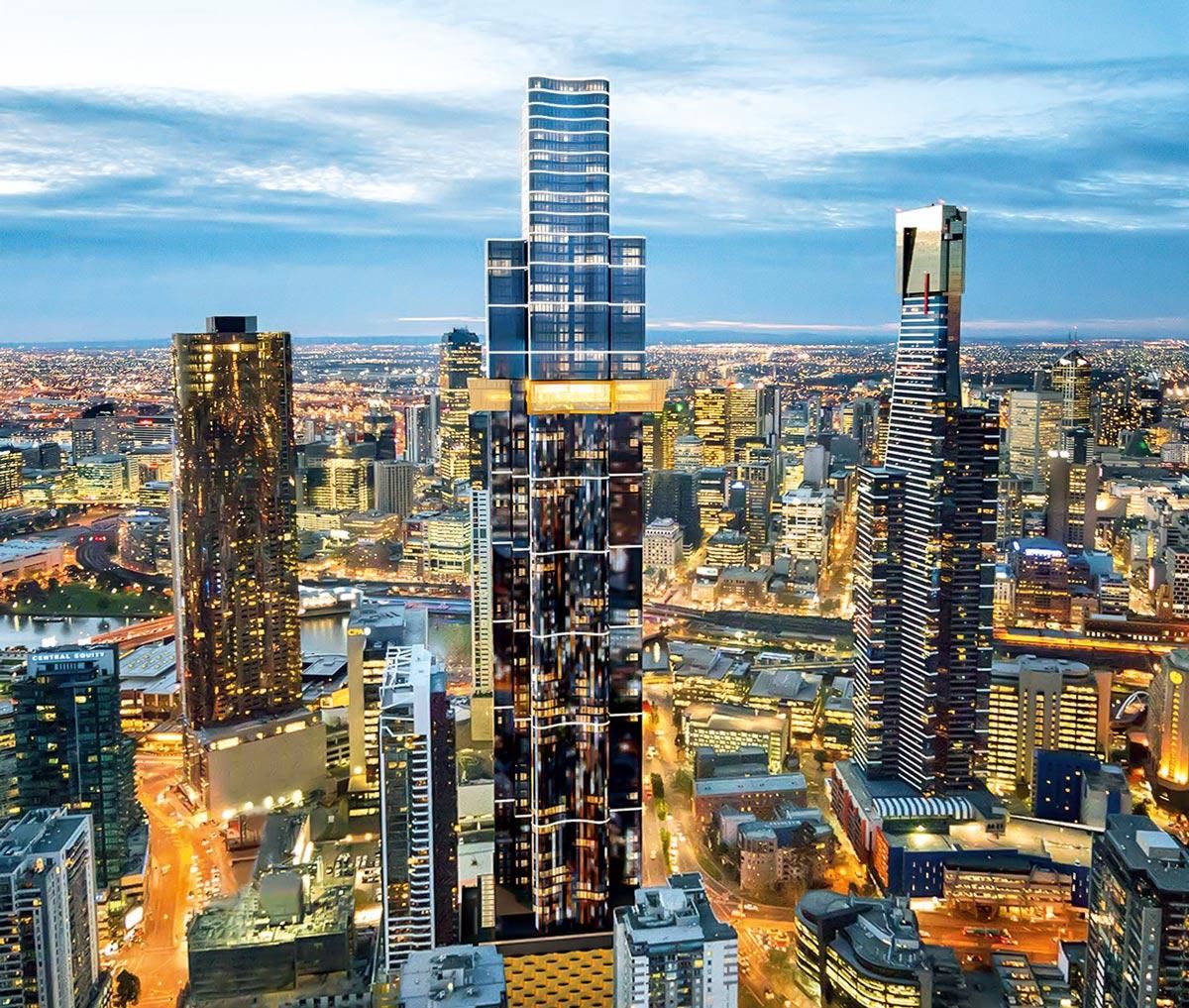
Australia 108 (previously 70 Southbank Boulevard) is a residential supertall skyscraper in the Southbank precinct of Melbourne, Victoria, Australia. Having topped out in November 2019, it became the tallest building in Australia by roof height, surpassing the Eureka Tower, and the second-tallest building in Australia by full height, surpassed by Q1 Tower.[3]
The World Class Land[4]development project consists of a 316.7 m (1,039 ft) tall apartment building with 1,105 apartments over 100 floors. Construction of the revised Fender Katsalidis Architects–design by Brookfield Multiplex commenced in 2015, and was completed in 2020.
Prior to its current form, plans were initially for a 226 m (741 ft) tall residential building with 72 floors. In 2012, these plans were revised and resubmitted in favour of a design with a height of 388 m (1,273 ft) and 108 storeys. This proposal was approved by the State Government in March 2013; however, it was shelved four months later after it struggled to meet conditions imposed by government authorities including VicRoads and the Civil Aviation Safety Authority.
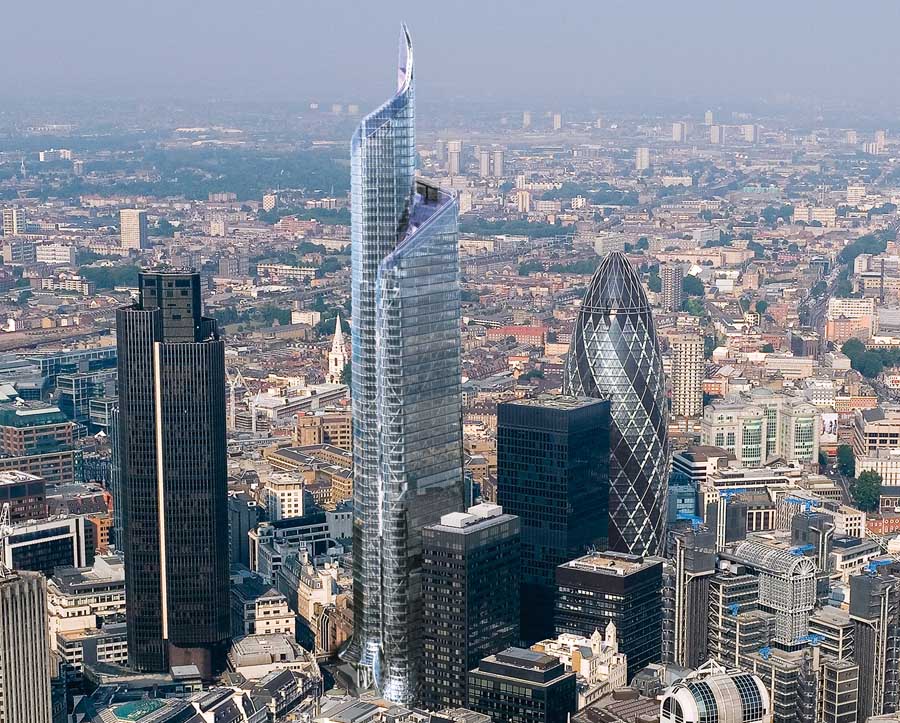
22 Bishopsgate, also known as Twentytwo, is a commercial skyscraper in London, United Kingdom. Completed in 2020, it occupies a prominent site in Bishopsgate, in the City of London financial district, and stands at 278 m (912 ft) tall with 62 storeys. The project replaces an earlier plan for a 288 m (945 ft) tower named The Pinnacle, on which construction was started in 2008 but suspended in 2012 following the Great Recession, with only the concrete core of the first seven storeys. The structure was later subjected to a re-design, out of which it became known by its postal address, 22 Bishopsgate.[4]
Under the original plans, The Pinnacle was to become the second-tallest building in both the United Kingdom and the European Union after The Shard, also in London. The Economic Development Corporation of Saudi Arabia and its development manager, Arab Investments, which largely funded the construction, invested £500 million in it in return for a majority stake in the structure.[5] However, the build was put on hold due to a lack of additional funding and letting commitments.
In 2013 it was reported that a review of the design and construction process, undertaken by original architects Kohn Pedersen Fox, agents CBRE and the developers, had been completed, with the building's "helter skelter" style exterior set to be retained.[6] In 2015, the site was sold to a consortium led by Axa Real Estate and a re-design with a simpler exterior, ultimately excluding the costly "helter skelter" shape, was submitted for public consultation before application for planning permission.
In April 2016, it was confirmed that property company Lipton Rogers and its joint venture partner, Axa IM – Real Assets, would complete the £1bn development in 2019. At 278 metres, the building was set to be the tallest in the City of London at that time and, due to potential loss of light to surrounding buildings, there had been objections to the development from several parties. However, City of London granted permission after considering the potential benefits of developing the building including the introduction of more floorspace to the area and the creation of new jobs.[7]
In 2017, plans were approved which redesigned the building and reduced its height further to 255 m due to concerns that the cranes used for its construction could interfere with the flight paths of the nearby London City Airport.[8][9] However, these plans were withdrawn after approval was granted for the previous 278-metre design.
The British Museum, in the Bloomsbury area of London, United Kingdom, is a public institution dedicated to human history, art and culture. Its permanent collection of some eight million works is among the largest and most comprehensive in existence,[3] having been widely sourced during the era of the British Empire. It documents the story of human culture from its beginnings to the present.[a] It was the first public national museum in the world.[4]
The British Museum was established in 1753, largely based on the collections of the Irish physician and scientist Sir Hans Sloane.[5] It first opened to the public in 1759, in Montagu House, on the site of the current building. Its expansion over the following 250 years was largely a result of expanding British colonisation and has resulted in the creation of several branch institutions, the first being the Natural History Museum in 1881.
In 1973, the British Library Act 1972 detached the library department from the British Museum, but it continued to host the now separated British Library in the same Reading Room and building as the museum until 1997. The museum is a non-departmental public body sponsored by the Department for Digital, Culture, Media and Sport, and as with all national museums in the UK it charges no admission fee, except for loan exhibitions.[6]
Its ownership of some of its most famous objects originating in other countries is disputed and remains the subject of international controversy, most notably in the case of the Parthenon Marbles.[7]
Sir Hans Sloane
Although today principally a museum of cultural art objects and antiquities, the British Museum was founded as a "universal museum". Its foundations lie in the will of the Irish physician and naturalist Sir Hans Sloane (1660–1753), a London-based doctor and scientist from Ulster. During the course of his lifetime, and particularly after he married the widow of a wealthy Jamaican planter[8], Sloane gathered a large collection of curiosities and, not wishing to see his collection broken up after death, he bequeathed it to King George II, for the nation, for a sum of £20,000.[9]
At that time, Sloane's collection consisted of around 71,000 objects of all kinds[10] including some 40,000 printed books, 7,000 manuscripts, extensive natural history specimens including 337 volumes of dried plants, prints and drawings including those by Albrecht Dürer and antiquities from Sudan, Egypt, Greece, Rome, the Ancient Near and Far East and the Americas.[11]
Foundation (1753)
On 7 June 1753, King George II gave his Royal Assent to the Act of Parliament which established the British Museum.[b] The British Museum Act 1753 also added two other libraries to the Sloane collection, namely the Cottonian Library, assembled by Sir Robert Cotton, dating back to Elizabethan times, and the Harleian Library, the collection of the Earls of Oxford. They were joined in 1757 by the "Old Royal Library", now the Royal manuscripts, assembled by various British monarchs. Together these four "foundation collections" included many of the most treasured books now in the British Library[13] including the Lindisfarne Gospels and the sole surviving manuscript of Beowulf.[c]
The British Museum was the first of a new kind of museum – national, belonging to neither church nor king, freely open to the public and aiming to collect everything. Sloane's collection, while including a vast miscellany of objects, tended to reflect his scientific interests.[14] The addition of the Cotton and Harley manuscripts introduced a literary and antiquarian element and meant that the British Museum now became both National Museum and library.[15]
Cabinet of curiosities (1753–1778)
The body of trustees decided on a converted 17th-century mansion, Montagu House, as a location for the museum, which it bought from the Montagu family for £20,000. The trustees rejected Buckingham House, on the site now occupied by Buckingham Palace, on the grounds of cost and the unsuitability of its location.[16][d]
With the acquisition of Montagu House, the first exhibition galleries and reading room for scholars opened on 15 January 1759.[17] At this time, the largest parts of collection were the library, which took up the majority of the rooms on the ground floor of Montagu House and the natural history objects, which took up an entire wing on the second state storey of the building. In 1763, the trustees of the British Museum, under the influence of Peter Collinson and William Watson, employed the former student of Carl Linnaeus, Daniel Solander to reclassify the natural history collection according to the Linnaean system, thereby making the Museum a public centre of learning accessible to the full range of European natural historians.[18] In 1823, King George IV[19] gave the King's Library assembled by George III, and Parliament gave the right to a copy of every book published in the country, thereby ensuring that the museum's library would expand indefinitely. During the few years after its foundation the British Museum received several further gifts, including the Thomason Collection of Civil War Tracts and David Garrick's library of 1,000 printed plays. The predominance of natural history, books and manuscripts began to lessen when in 1772 the museum acquired for £8,410 its first significant antiquities in Sir William Hamilton's "first" collection of Greek vases.[20]
Indolence and energy (1778–1800)
From 1778, a display of objects from the South Seas brought back from the round-the-world voyages of Captain James Cook and the travels of other explorers fascinated visitors with a glimpse of previously unknown lands. The bequest of a collection of books, engraved gems, coins, prints and drawings by Clayton Mordaunt Cracherode in 1800 did much to raise the museum's reputation; but Montagu House became increasingly crowded and decrepit and it was apparent that it would be unable to cope with further expansion.[21]
The museum's first notable addition towards its collection of antiquities, since its foundation, was by Sir William Hamilton (1730–1803), British Ambassador to Naples, who sold his collection of Greek and Roman artefacts to the museum in 1784 together with a number of other antiquities and natural history specimens. A list of donations to the museum, dated 31 January 1784, refers to the Hamilton bequest of a "Colossal Foot of an Apollo in Marble". It was one of two antiquities of Hamilton's collection drawn for him by Francesco Progenie, a pupil of Pietro Fabris, who also contributed a number of drawings of Mount Vesuvius sent by Hamilton to the Royal Society in London.
Growth and change (1800–1825)
In the early 19th century the foundations for the extensive collection of sculpture began to be laid and Greek, Roman and Egyptian artefacts dominated the antiquities displays. After the defeat of the French campaign in the Battle of the Nile, in 1801, the British Museum acquired more Egyptian sculptures and in 1802 King George III presented the Rosetta Stone – key to the deciphering of hieroglyphs.[22] Gifts and purchases from Henry Salt, British consul general in Egypt, beginning with the Colossal bust of Ramesses II in 1818, laid the foundations of the collection of Egyptian Monumental Sculpture.[23] Many Greek sculptures followed, notably the first purpose-built exhibition space, the Charles Towneley collection, much of it Roman Sculpture, in 1805. In 1806, Thomas Bruce, 7th Earl of Elgin, ambassador to the Ottoman Empire from 1799 to 1803 removed the large collection of marble sculptures from the Parthenon, on the Acropolis in Athens and transferred them to the UK. In 1816 these masterpieces of western art, were acquired by The British Museum by Act of Parliament and deposited in the museum thereafter.[24] The collections were supplemented by the Bassae frieze from Phigaleia, Greece in 1815. The Ancient Near Eastern collection also had its beginnings in 1825 with the purchase of Assyrian and Babylonian antiquities from the widow of Claudius James Rich.[25]
In 1802 a buildings committee was set up to plan for expansion of the museum, and further highlighted by the donation in 1822 of the King's Library, personal library of King George III's, comprising 65,000 volumes, 19,000 pamphlets, maps, charts and topographical drawings.[26] The neoclassical architect, Sir Robert Smirke, was asked to draw up plans for an eastern extension to the museum "... for the reception of the Royal Library, and a Picture Gallery over it ..."[27] and put forward plans for today's quadrangular building, much of which can be seen today. The dilapidated Old Montagu House was demolished and work on the King's Library Gallery began in 1823. The extension, the East Wing, was completed by 1831. However, following the founding of the National Gallery, London in 1824,[e] the proposed Picture Gallery was no longer needed, and the space on the upper floor was given over to the Natural history collections.[28]
The largest building site in Europe (1825–1850)
The museum became a construction site as Sir Robert Smirke's grand neo-classical building gradually arose. The King's Library, on the ground floor of the East Wing, was handed over in 1827, and was described as one of the finest rooms in London. Although it was not fully open to the general public until 1857, special openings were arranged during The Great Exhibition of 1851. In spite of dirt and disruption the collections grew, outpacing the new building.[citation needed]
In 1840, the museum became involved in its first overseas excavations, Charles Fellows's expedition to Xanthos, in Asia Minor, whence came remains of the tombs of the rulers of ancient Lycia, among them the Nereid and Payava monuments. In 1857, Charles Newton was to discover the 4th-century BC Mausoleum of Halikarnassos, one of the Seven Wonders of the Ancient World. In the 1840s and 1850s the museum supported excavations in Assyria by A.H. Layard and others at sites such as Nimrud and Nineveh. Of particular interest to curators was the eventual discovery of Ashurbanipal's great library of cuneiform tablets, which helped to make the museum a focus for Assyrian studies.[29]
Sir Thomas Grenville (1755–1846), a trustee of the British Museum from 1830, assembled a library of 20,240 volumes, which he left to the museum in his will. The books arrived in January 1847 in twenty-one horse-drawn vans. The only vacant space for this large library was a room originally intended for manuscripts, between the Front Entrance Hall and the Manuscript Saloon. The books remained here until the British Library moved to St Pancras in 1998.
Collecting from the wider world (1850–1875)
The opening of the forecourt in 1852 marked the completion of Robert Smirke's 1823 plan, but already adjustments were having to be made to cope with the unforeseen growth of the collections. Infill galleries were constructed for Assyrian sculptures and Sydney Smirke's Round Reading Room, with space for a million books, opened in 1857. Because of continued pressure on space the decision was taken to move natural history to a new building in South Kensington, which would later become the British Museum of Natural History.
Roughly contemporary with the construction of the new building was the career of a man sometimes called the "second founder" of the British Museum, the Italian librarian Anthony Panizzi. Under his supervision, the British Museum Library (now part of the British Library) quintupled in size and became a well-organised institution worthy of being called a national library, the largest library in the world after the National Library of Paris.[15] The quadrangle at the centre of Smirke's design proved to be a waste of valuable space and was filled at Panizzi's request by a circular Reading Room of cast iron, designed by Smirke's brother, Sydney Smirke.[30]
Until the mid-19th century, the museum's collections were relatively circumscribed but, in 1851, with the appointment to the staff of Augustus Wollaston Franks to curate the collections, the museum began for the first time to collect British and European medieval antiquities, prehistory, branching out into Asia and diversifying its holdings of ethnography. A real coup for the museum was the purchase in 1867, over French objections, of the Duke of Blacas's wide-ranging and valuable collection of antiquities. Overseas excavations continued and John Turtle Wood discovered the remains of the 4th century BC Temple of Artemis at Ephesos, another Wonder of the Ancient World.[31]
Scholarship and legacies (1875–1900)
The natural history collections were an integral part of the British Museum until their removal to the new British Museum of Natural History in 1887, nowadays the Natural History Museum. With the departure and the completion of the new White Wing (fronting Montague Street) in 1884, more space was available for antiquities and ethnography and the library could further expand. This was a time of innovation as electric lighting was introduced in the Reading Room and exhibition galleries.[32]
The William Burges collection of armoury was bequeathed to the museum in 1881. In 1882, the museum was involved in the establishment of the independent Egypt Exploration Fund (now Society) the first British body to carry out research in Egypt. A bequest from Miss Emma Turner in 1892 financed excavations in Cyprus. In 1897 the death of the great collector and curator, A. W. Franks, was followed by an immense bequest of 3,300 finger rings, 153 drinking vessels, 512 pieces of continental porcelain, 1,500 netsuke, 850 inro, over 30,000 bookplates and miscellaneous items of jewellery and plate, among them the Oxus Treasure.[33]
In 1898 Baron Ferdinand de Rothschild bequeathed the Waddesdon Bequest, the glittering contents from his New Smoking Room at Waddesdon Manor. This consisted of almost 300 pieces of objets d'art et de vertu which included exquisite examples of jewellery, plate, enamel, carvings, glass and maiolica, among them the Holy Thorn Reliquary, probably created in the 1390s in Paris for John, Duke of Berry. The collection was in the tradition of a schatzkammer or treasure house such as those formed by the Renaissance princes of Europe.[34] Baron Ferdinand's will was most specific, and failure to observe the terms would make it void, the collection should be
placed in a special room to be called the Waddesdon Bequest Room separate and apart from the other contents of the Museum and thenceforth for ever thereafter, keep the same in such room or in some other room to be substituted for it.[34]
These terms are still observed, and the collection occupies room 45, although it moved to new quarters in 2015.
New century, new building (1900–1925)
By the last years of the 19th century, The British Museum's collections had increased to the extent that its building was no longer large enough. In 1895 the trustees purchased the 69 houses surrounding the museum with the intention of demolishing them and building around the west, north and east sides of the museum. The first stage was the construction of the northern wing beginning 1906.
All the while, the collections kept growing. Emil Torday collected in Central Africa, Aurel Stein in Central Asia, D.G. Hogarth, Leonard Woolley and T. E. Lawrence excavated at Carchemish. Around this time, the American collector and philanthropist J Pierpont Morgan donated a substantial number of objects to the museum,[35] including William Greenwell's collection of prehistoric artefacts from across Europe which he had purchased for £10,000 in 1908. Morgan had also acquired a major part of Sir John Evans's coin collection, which was later sold to the museum by his son John Pierpont Morgan Junior in 1915. In 1918, because of the threat of wartime bombing, some objects were evacuated via the London Post Office Railway to Holborn, the National Library of Wales (Aberystwyth) and a country house near Malvern. On the return of antiquities from wartime storage in 1919 some objects were found to have deteriorated. A conservation laboratory was set up in May 1920 and became a permanent department in 1931. It is today the oldest in continuous existence.[36] In 1923, the British Museum welcomed over one million visitors.
Disruption and reconstruction (1925–1950)
New mezzanine floors were constructed and book stacks rebuilt in an attempt to cope with the flood of books. In 1931, the art dealer Sir Joseph Duveen offered funds to build a gallery for the Parthenon sculptures. Designed by the American architect John Russell Pope, it was completed in 1938. The appearance of the exhibition galleries began to change as dark Victorian reds gave way to modern pastel shades.[f] However, in August 1939, due to the imminence of war and the likelihood of air-raids, the Parthenon Sculptures, along with the museum's most valued collections, were dispersed to secure basements, country houses, Aldwych Underground station, the National Library of Wales and a quarry. The evacuation was timely, for in 1940 the Duveen Gallery was severely damaged by bombing.[38] Meanwhile, prior to the war, the Nazis had sent a researcher to the British Museum for several years with the aim of "compiling an anti-Semitic history of Anglo-Jewry."[39] After the war, the museum continued to collect from all countries and all centuries: among the most spectacular additions were the 2600 BC Mesopotamian treasure from Ur, discovered during Leonard Woolley's 1922–34 excavations. Gold, silver and garnet grave goods from the Anglo-Saxon ship burial at Sutton Hoo (1939) and late Roman silver tableware from Mildenhall, Suffolk (1946). The immediate post-war years were taken up with the return of the collections from protection and the restoration of the museum after the Blitz. Work also began on restoring the damaged Duveen Gallery.
A new public face (1950–1975)
In 1953, the museum celebrated its bicentenary. Many changes followed: the first full-time in house designer and publications officer were appointed in 1964, the Friends organisation was set up in 1968, an Education Service established in 1970 and publishing house in 1973. In 1963, a new Act of Parliament introduced administrative reforms. It became easier to lend objects, the constitution of the board of trustees changed and the Natural History Museum became fully independent. By 1959 the Coins and Medals office suite, completely destroyed during the war, was rebuilt and re-opened, attention turned towards the gallery work with new tastes in design leading to the remodelling of Robert Smirke's Classical and Near Eastern galleries.[40] In 1962 the Duveen Gallery was finally restored and the Parthenon Sculptures were moved back into it, once again at the heart of the museum.[g]
By the 1970s the museum was again expanding. More services for the public were introduced; visitor numbers soared, with the temporary exhibition "Treasures of Tutankhamun" in 1972, attracting 1,694,117 visitors, the most successful in British history. In the same year the Act of Parliament establishing the British Library was passed, separating the collection of manuscripts and printed books from the British Museum. This left the museum with antiquities; coins, medals and paper money; prints & drawings; and ethnography. A pressing problem was finding space for additions to the library which now required an extra 1 1⁄4 miles (2.0 km) of shelving each year. The Government suggested a site at St Pancras for the new British Library but the books did not leave the museum until 1997.
The Great Court emerges (1975–2000)
The departure of the British Library to a new site at St Pancras, finally achieved in 1998, provided the space needed for the books. It also created the opportunity to redevelop the vacant space in Robert Smirke's 19th-century central quadrangle into the Queen Elizabeth II Great Court – the largest covered square in Europe – which opened in 2000. The ethnography collections, which had been housed in the short-lived Museum of Mankind at 6 Burlington Gardens from 1970, were returned to new purpose-built galleries in the museum in 2000.
The museum again readjusted its collecting policies as interest in "modern" objects: prints, drawings, medals and the decorative arts reawakened. Ethnographical fieldwork was carried out in places as diverse as New Guinea, Madagascar, Romania, Guatemala and Indonesia and there were excavations in the Near East, Egypt, Sudan and the UK. The Weston Gallery of Roman Britain, opened in 1997, displayed a number of recently discovered hoards which demonstrated the richness of what had been considered an unimportant part of the Roman Empire. The museum turned increasingly towards private funds for buildings, acquisitions and other purposes.[42]
The British Museum today
Today the museum no longer houses collections of natural history, and the books and manuscripts it once held now form part of the independent British Library. The museum nevertheless preserves its universality in its collections of artefacts representing the cultures of the world, ancient and modern. The original 1753 collection has grown to over thirteen million objects at the British Museum, 70 million at the Natural History Museum and 150 million at the British Library.
The Round Reading Room, which was designed by the architect Sydney Smirke, opened in 1857. For almost 150 years researchers came here to consult the museum's vast library. The Reading Room closed in 1997 when the national library (the British Library) moved to a new building at St Pancras. Today it has been transformed into the Walter and Leonore Annenberg Centre.
With the bookstacks in the central courtyard of the museum empty, the demolition for Lord Foster's glass-roofed Great Court could begin. The Great Court, opened in 2000, while undoubtedly improving circulation around the museum, was criticised for having a lack of exhibition space at a time when the museum was in serious financial difficulties and many galleries were closed to the public. At the same time the African collections that had been temporarily housed in 6 Burlington Gardens were given a new gallery in the North Wing funded by the Sainsbury family – with the donation valued at £25 million.[43]
As part of its very large website, the museum has the largest online database of objects in the collection of any museum in the world, with 2,000,000 individual object entries, 650,000 of them illustrated, online at the start of 2012.[44] There is also a "Highlights" database with longer entries on over 4,000 objects, and several specialised online research catalogues and online journals (all free to access).[45] In 2013 the museum's website received 19.5 millions visits, an increase of 47% from the previous year.[46]
In 2013 the museum received a record 6.7 million visitors, an increase of 20% from the previous year.[46] Popular exhibitions including "Life and Death in Pompeii and Herculaneum" and "Ice Age Art" are credited with helping fuel the increase in visitors.[47] Plans were announced in September 2014 to recreate the entire building along with all exhibits in the video game Minecraft in conjunction with members of the public.
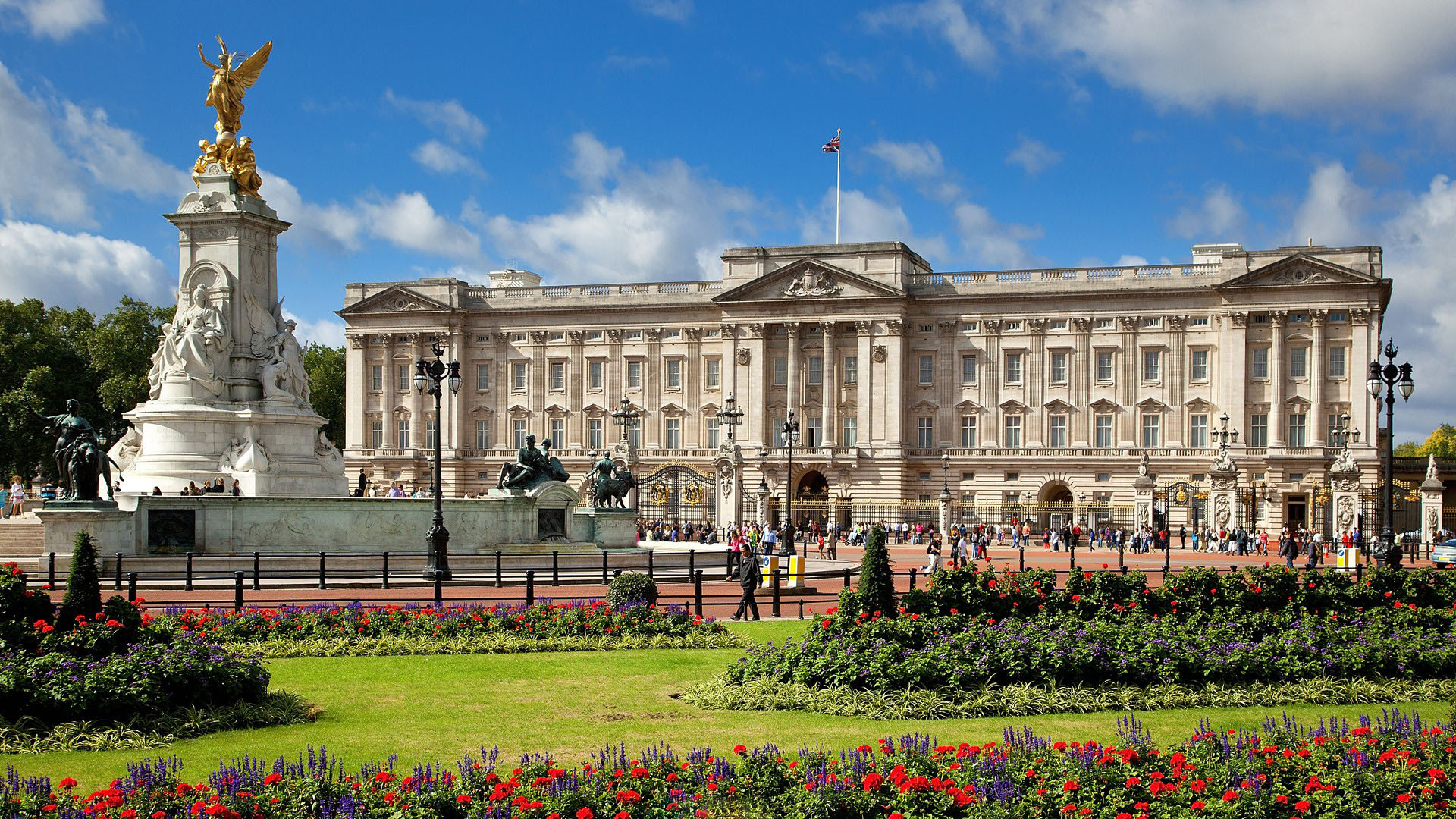
Buckingham Palace (UK: /ˈbʌkɪŋəm/)[1] is the London residence and administrative headquarters of the monarch of the United Kingdom.[a][2] Located in the City of Westminster, the palace is often at the centre of state occasions and royal hospitality. It has been a focal point for the British people at times of national rejoicing and mourning.
Originally known as Buckingham House, the building at the core of today's palace was a large townhouse built for the Duke of Buckingham in 1703 on a site that had been in private ownership for at least 150 years. It was acquired by King George III in 1761[3] as a private residence for Queen Charlotte and became known as The Queen's House. During the 19th century it was enlarged, principally by architects John Nash and Edward Blore, who constructed three wings around a central courtyard. Buckingham Palace became the London residence of the British monarch on the accession of Queen Victoria in 1837.
The last major structural additions were made in the late 19th and early 20th centuries, including the East Front, which contains the well-known balcony on which the British royal family traditionally congregates to greet crowds. A German bomb destroyed the palace chapel during the Second World War; the Queen's Gallery was built on the site and opened to the public in 1962 to exhibit works of art from the Royal Collection.
The original early-19th-century interior designs, many of which survive, include widespread use of brightly coloured scagliola and blue and pink lapis, on the advice of Sir Charles Long. King Edward VII oversaw a partial redecoration in a Belle Époque cream and gold colour scheme. Many smaller reception rooms are furnished in the Chinese regency style with furniture and fittings brought from the Royal Pavilion at Brighton and from Carlton House. The palace has 775 rooms, and the garden is the largest private garden in London. The state rooms, used for official and state entertaining, are open to the public each year for most of August and September and on some days in winter and spring.
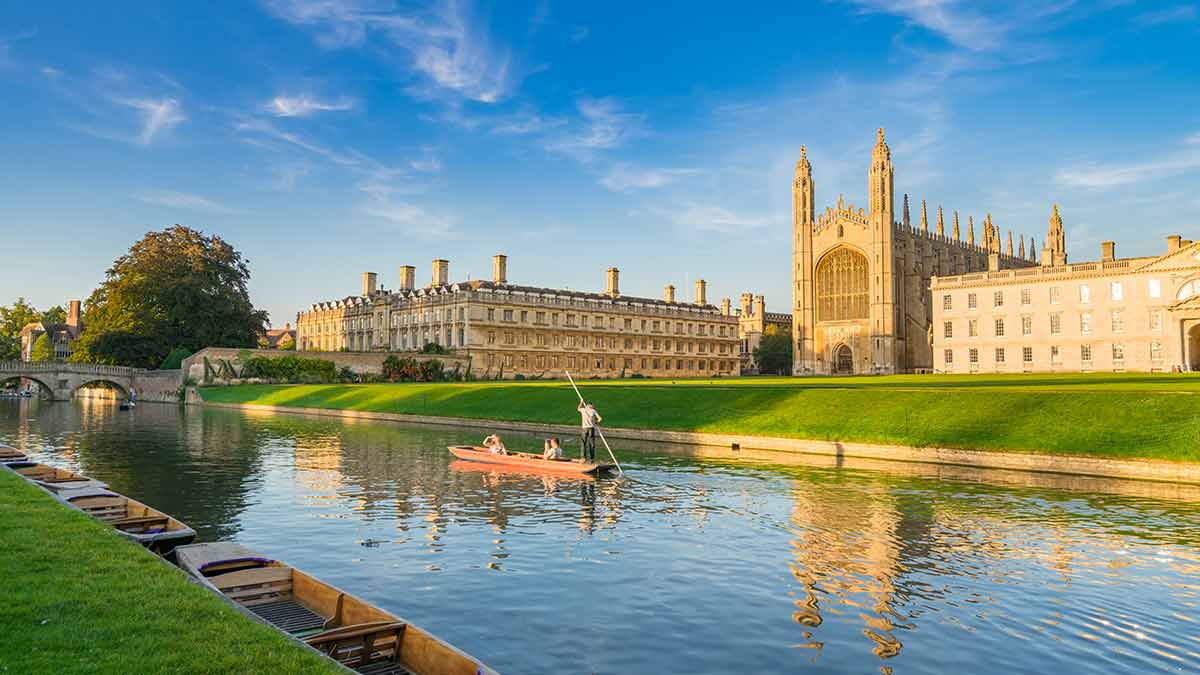
Cambridge (/ˈkeɪmbrɪdʒ/[2] KAYM-brij) is a university city and the county town of Cambridgeshire, England, on the River Cam approximately 55 miles (89 km) north of London. At the United Kingdom Census 2011, the population of the Cambridge built-up area (which is larger than the remit of Cambridge City Council) was 158,434 including 29,327 students.[3] Cambridge became an important trading centre during the Roman and Viking ages, and there is archaeological evidence of settlement in the area as early as the Bronze Age. The first town charters were granted in the 12th century, although modern city status was not officially conferred until 1951.
The University of Cambridge was founded in 1209.[4] The buildings of the university include King's College Chapel, Cavendish Laboratory, and the Cambridge University Library, one of the largest legal deposit libraries in the world. The city's skyline is dominated by several college buildings, along with the spire of the Our Lady and the English Martyrs Church, and the chimney of Addenbrooke's Hospital. Anglia Ruskin University, which evolved from the Cambridge School of Art and the Cambridgeshire College of Arts and Technology, also has its main campus in the city.
Cambridge is at the heart of the high-technology Silicon Fen with industries such as software and bioscience and many start-up companies born out of the university. Over 40 per cent of the workforce have a higher education qualification, more than twice the national average. The Cambridge Biomedical Campus, one of the largest biomedical research clusters in the world includes the headquarters of AstraZeneca, a hotel, and the relocated Royal Papworth Hospital.[5]
The first game of association football took place at Parker's Piece. The Strawberry Fair music and arts festival and Midsummer Fair are held on Midsummer Common, and the annual Cambridge Beer Festival takes place on Jesus Green. The city is adjacent to the M11 and A14 roads. Cambridge station is less than an hour from London King's Cross railway station.
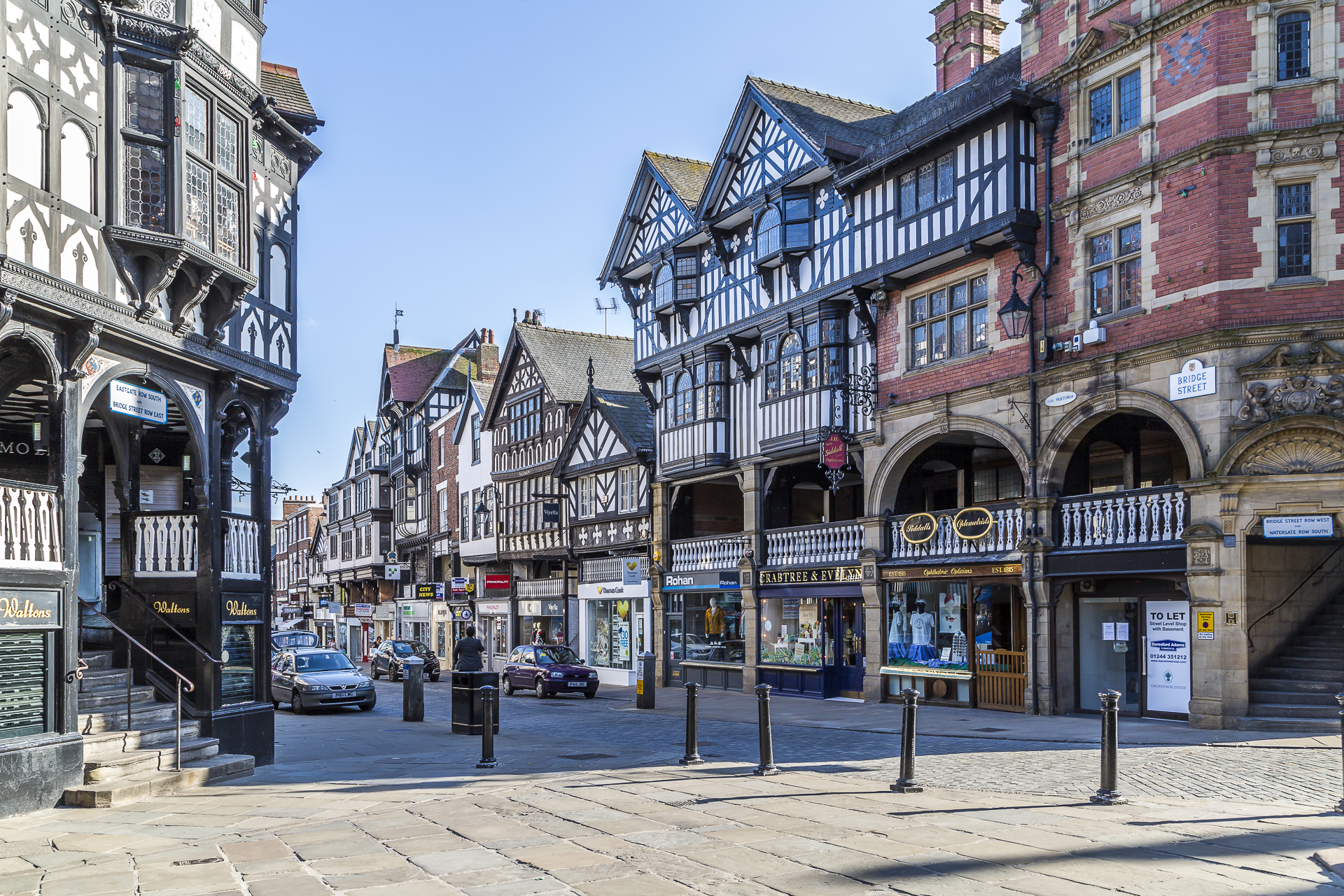
Chester is a walled cathedral city in Cheshire, England. It is located on the River Dee, close to the English-Welsh border. With a population of 79,645 in 2011,[2] it is the most populous settlement of Cheshire West and Chester (a unitary authority which had a population of 329,608 in 2011)[2] and serves as its administrative headquarters. It is also the historic county town of Cheshire and the second-largest settlement in Cheshire after Warrington.
Chester was founded in 79 AD as a "castrum" or Roman fort with the name Deva Victrix during the reign of Emperor Vespasian. One of the main army camps in Roman Britain, Deva later became a major civilian settlement. In 689, King Æthelred of Mercia founded the Minster Church of West Mercia, which later became Chester's first cathedral, and the Angles extended and strengthened the walls to protect the city against the Danes. Chester was one of the last cities in England to fall to the Normans, and William the Conqueror ordered the construction of a castle to dominate the town and the nearby Welsh border. Chester was granted city status in 1541.
The city walls of Chester are some of the best-preserved in the country and have Grade I listed status. It has a number of medieval buildings, but many of the black-and-white buildings within the city centre are Victorian restorations, originating from the Black-and-white Revival movement.[3] Apart from a 100-metre (330 ft) section, the walls are almost complete.[4] The Industrial Revolution brought railways, canals, and new roads to the city, which saw substantial expansion and development; Chester Town Hall and the Grosvenor Museum are examples of Victorian architecture from this period. Tourism, the retail industry, public administration, and financial services are important to the modern economy.
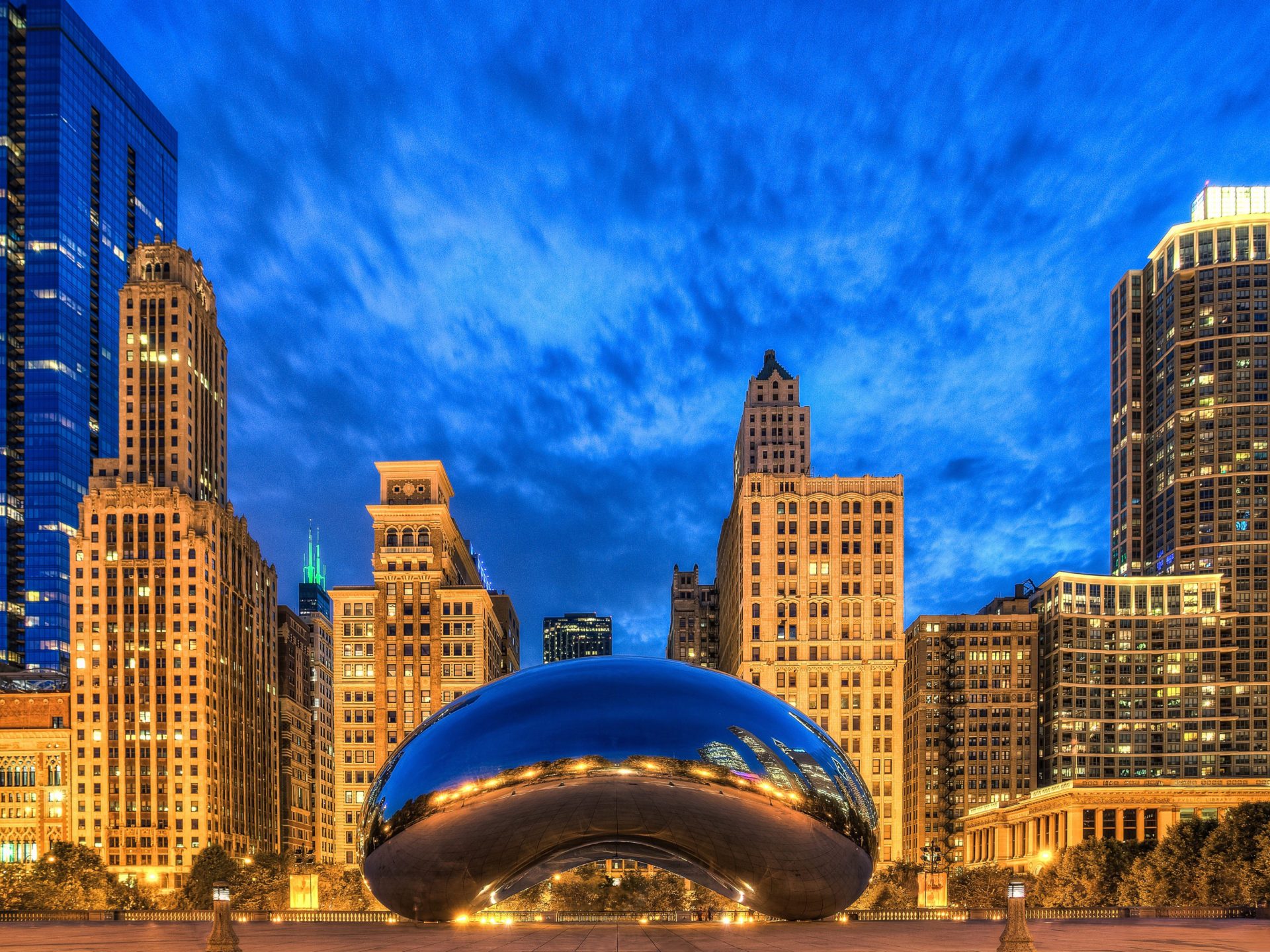
Cloud Gate is a public sculpture by Indian-born British artist Anish Kapoor, that is the centerpiece of AT&T Plaza at Millennium Park in the Loop community area of Chicago, Illinois. The sculpture and AT&T Plaza are located on top of Park Grill, between the Chase Promenade and McCormick Tribune Plaza & Ice Rink. Constructed between 2004 and 2006, the sculpture is nicknamed "The Bean" because of its shape, a name Kapoor initially disliked, but later grew fond of. Made up of 168 stainless steel plates welded together, its highly polished exterior has no visible seams. It measures 33 by 66 by 42 feet (10 by 20 by 13 m), and weighs 110 short tons (100 t; 98 long tons).
Kapoor's design was inspired by liquid mercury and the sculpture's surface reflects and distorts the city's skyline. Visitors are able to walk around and under Cloud Gate's 12-foot (3.7 m) high arch. On the underside is the "omphalos" (Greek for "navel"), a concave chamber that warps and multiplies reflections. The sculpture builds upon many of Kapoor's artistic themes, and it is popular with tourists as a photo-taking opportunity for its unique reflective properties.
The sculpture was the result of a design competition. After Kapoor's design was chosen, numerous technological concerns regarding the design's construction and assembly arose, in addition to concerns regarding the sculpture's upkeep and maintenance. Various experts were consulted, some of whom believed the design could not be implemented. Eventually, a feasible method was found, but the sculpture's construction fell behind schedule. It was unveiled in an incomplete form during the Millennium Park grand opening celebration in 2004, before being concealed again while it was completed. Cloud Gate was formally dedicated on May 15, 2006, and has since gained considerable popularity, both domestically and internationally.
Lying between Lake Michigan to the east and the Loop to the west, Grant Park has been Chicago's front yard since the mid-19th century. Its northwest corner, north of Monroe Street and the Art Institute, east of Michigan Avenue, south of Randolph Street, and west of Columbus Drive, had been Illinois Central rail yards and parking lots until 1997, when it was made available for development by the city as Millennium Park.[1] For 2007, the park was Chicago's second largest tourist attraction, trailing only Navy Pier.[2]
In 1999, Millennium Park officials and a group of art collectors, curators and architects reviewed the artistic works of 30 different artists and asked two for proposals. American artist Jeff Koons submitted a proposal to erect a permanent 150-foot (46 m) sculpture of a playground slide;[3][4] his glass and steel design featured an observation deck 90 feet (27 m) above the ground that was accessible via an elevator.[5] The committee chose the second design by internationally acclaimed artist Anish Kapoor. Measuring 33 by 66 by 42 feet (10 by 20 by 13 m) and weighing 110 short tons (100 t; 98 long tons), the proposal featured a seamless, stainless steel surface inspired by liquid mercury.[6] This mirror-like surface would reflect the Chicago skyline, but its elliptical shape would distort and twist the reflected image.[7] As visitors walk
In the underside of the sculpture is the omphalos, an indentation whose mirrored surface provides multiple reflections of any subject situated beneath it.[8] The apex of the omphalos is 27 feet (8.2 m) above the ground. The concave underside allows visitors to walk underneath to see the omphalos, and through its arch to the other side so that they view the entire structure.[9] During the grand opening week in July 2004, press reports described the omphalos as the "spoon-like underbelly".[10][11] The stainless steel sculpture was originally envisioned as the centerpiece of the Lurie Garden at the southeast corner of the park. However, Park officials believed the piece was too large for the Lurie Garden and decided to locate it at AT&T Plaza, despite Kapoor's objections.[12] Skyscrapers to the north along East Randolph Street, including The Heritage, the Smurfit-Stone Building, Two Prudential Plaza, One Prudential Plaza, and Aon Center are visible, reflected on both the east and west sides of the sculpture. around the structure, its surface acts like a fun-house mirror as it distorts their reflections.[13]
Although Kapoor does not draw with computers, computer modeling was essential to the process of analyzing the complex form,[14] which created numerous issues. Since the sculpture was expected to be outdoors, concerns arose that it might retain and conduct heat in a way that would make it too hot to touch during the summer and so cold that one's tongue might stick to it during the winter. The extreme temperature variation between seasons was also feared to weaken the structure. Graffiti, bird droppings and fingerprints were also potential problems, as they would affect the aesthetics of the surface.[4][15] The most pressing issue was the need to create a single seamless exterior for the external shell, a feat architect Norman Foster once believed to be nearly impossible.[15]
While the sculpture was being constructed, public and media outlets nicknamed it "The Bean" because of its shape, a name that Kapoor described as "completely stupid".[12] Months later, Kapoor officially named the piece Cloud Gate.[16] (Kapoor eventually accepted the nickname of "The Bean".[17]) Critical reviews describe the sculpture as a passage between realms.[18] Three-quarters of the sculpture's external surface reflects the sky and the name refers to it acting as a type of gate that helps bridge the space between the sky and the viewer.[19] The sculpture and plaza are sometimes referred to jointly as "Cloud Gate on the AT&T Plaza".[20] It is Kapoor's first public outdoor work in the United States,[20] and is the work by which he is best known in the country according to the Financial Times.
Lincoln Center for the Performing Arts (simply known as Lincoln Center) is a 16.3-acre (6.6-hectare) complex of buildings in the Lincoln Square neighborhood of the borough of Manhattan in New York City. It hosts many notable performing arts organizations, which are nationally and internationally renowned, including the New York Philharmonic, the Metropolitan Opera, the New York City Ballet and the New York City Opera.
A consortium of civic leaders and others led by, and under the initiative of, John D. Rockefeller III built Lincoln Center as part of the "Lincoln Square Renewal Project" during Robert Moses' program of urban renewal in the 1950s and 1960s.[1] Respected architects were contracted to design the major buildings on the site, and over the next thirty years the previously diverse working class area around Lincoln Center was replaced with a conglomeration of high culture to please the tastes of the consortium.[2]
Rockefeller was Lincoln Center's inaugural president from 1956 and became its chairman in 1961. He is credited with raising more than half of the $184.5 million in private funds needed to build the complex, including drawing on his own funds; the Rockefeller Brothers Fund also contributed to the project.[1] The center's three buildings, David Geffen Hall (formerly Avery Fisher Hall), David H. Koch Theater (formerly the New York State Theater) and the Metropolitan Opera House were opened in 1962, 1964 and 1966, respectively.
While the center may have been named because it was located in the Lincoln Square neighborhood, it is unclear whether the area was named as a tribute to U.S. President Abraham Lincoln. The name was bestowed on the area in 1906 by the New York City Board of Aldermen, but records give no reason for choosing that name.[3] There has long been speculation that the name came from a local landowner, because the square was previously named Lincoln Square. City records from the time show only the names Johannes van Bruch, Thomas Hall, Stephan de Lancey, James de Lancey, James de Lancey, Jr. and John Somerindyck as area property owners. One speculation is that references to President Lincoln were omitted from the records because the mayor in 1906 was George B. McClellan Jr., son of General George B. McClellan, who was general-in-chief of the Union Army early in the American Civil War and a bitter rival of Lincoln's.[4]

 Architecture
Architecture
 England
England
 Eurovision Song Contest,ESC
Eurovision Song Contest,ESC

 Financial
Financial
 ***Global Financial Center
***Global Financial Center
 UEFA European Championship 2020
UEFA European Championship 2020

 History
History
 N 2000 - 2100 AD
N 2000 - 2100 AD

 History
History
 M 1500 - 2000 AD
M 1500 - 2000 AD

 History
History
 J 0 - 500 AD
J 0 - 500 AD

 History
History
 K 500 - 1000 AD
K 500 - 1000 AD

 History
History
 L 1000 - 1500 AD
L 1000 - 1500 AD

 International cities
International cities
 ***Global Urban Economic Competitiveness
***Global Urban Economic Competitiveness
 ITU World Championship Series
ITU World Championship Series

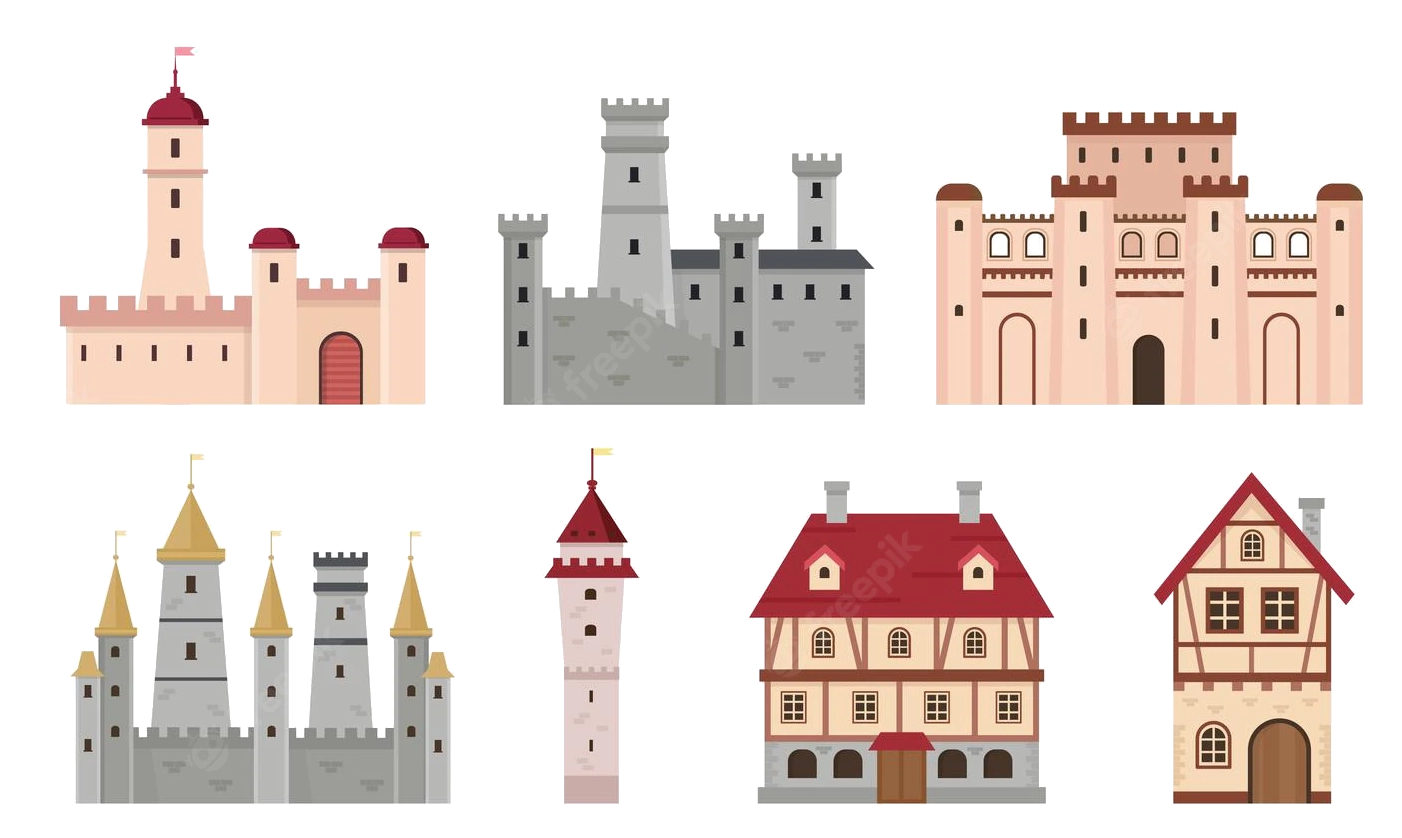 Medieval cities in Europe
Medieval cities in Europe
 Olympic Summer Games
Olympic Summer Games
 1908 Summer Olympics
1908 Summer Olympics
 1944 Summer Olympics
1944 Summer Olympics
 1948 Summer Olympics
1948 Summer Olympics
 2012 Summer Olympics
2012 Summer Olympics
 Silk road
Silk road

 Sport
Sport

 Sport
Sport
 Triathlon
Triathlon
 United Kingdom
United Kingdom

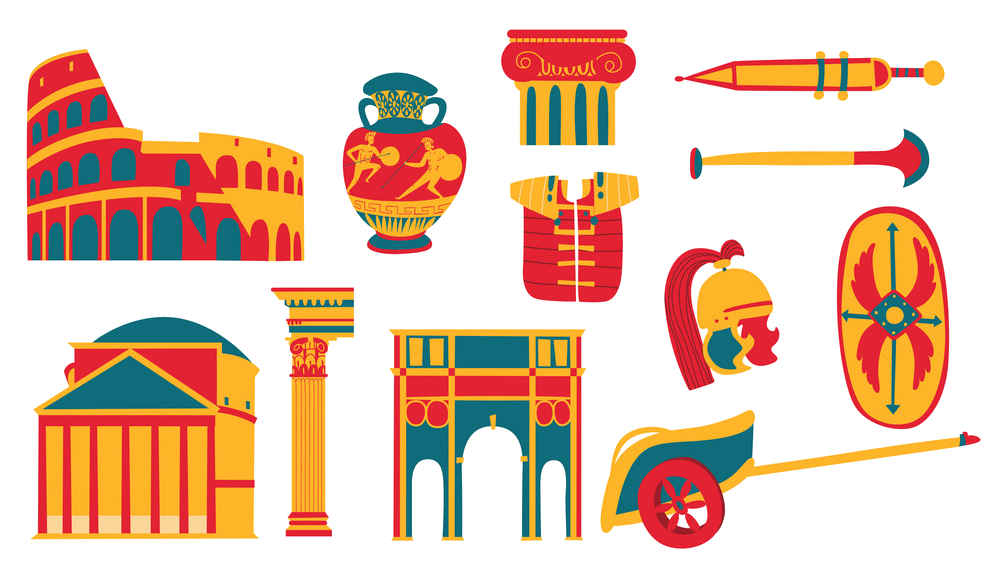 Cities founded by the Romans
Cities founded by the Romans

 World Heritage
World Heritage

 Important port
Important port
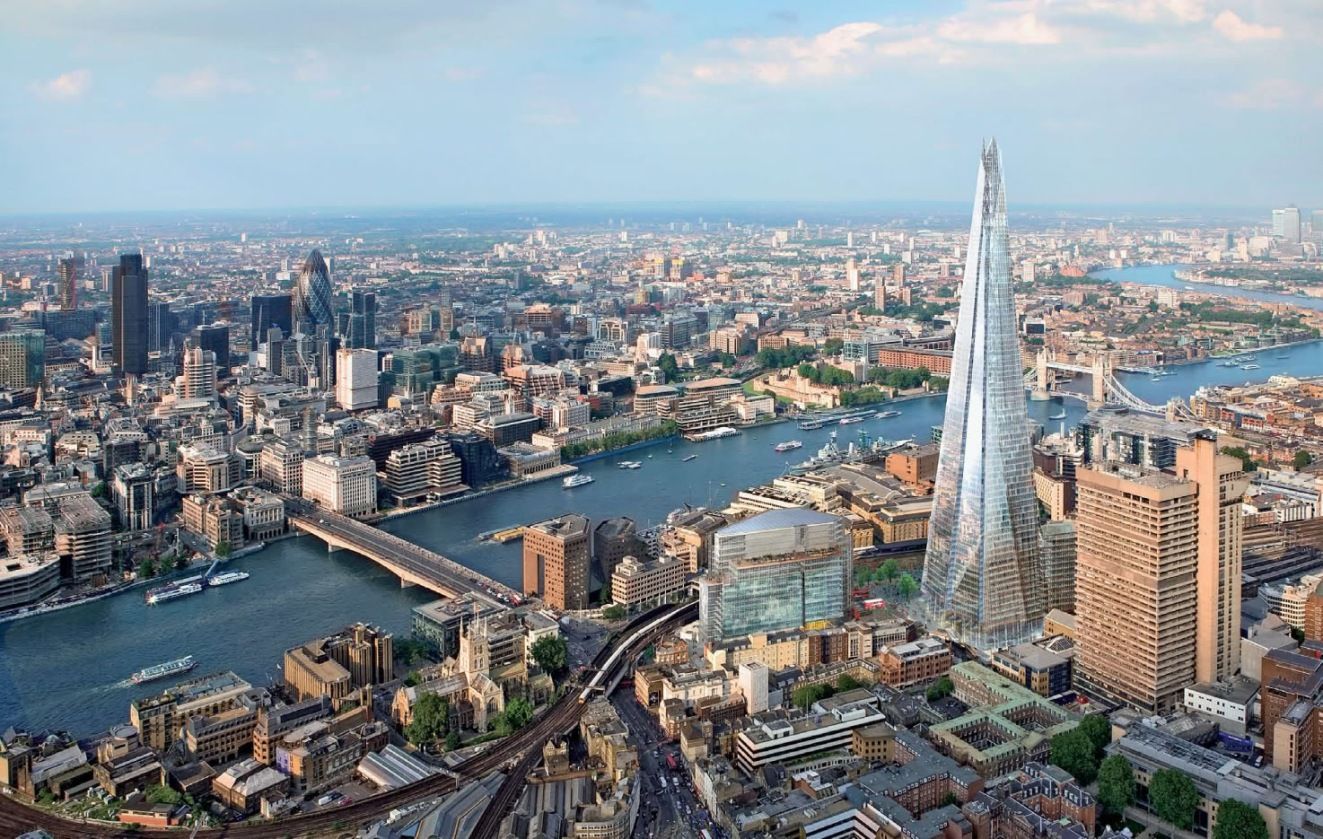
London (/ˈlʌndən/ ( listen) LUN-dən) is the capital and most populous city of England and the United Kingdom.[8][9] Standing on the River Thames in the south east of the island of Great Britain, London has been a major settlement for two millennia. It was founded by the Romans, who named it Londinium.[10] London's ancient core, the City of London, largely retains its 1.12-square-mile (2.9 km2) medieval boundaries. Since at least the 19th century, "London" has also referred to the metropolis around this core, historically split between Middlesex, Essex, Surrey, Kent and Hertfordshire,[11][12][13] which today largely makes up Greater London,[14][15][note 1] a region governed by the Mayor of London and the London Assembly.[16][note 2][17]
listen) LUN-dən) is the capital and most populous city of England and the United Kingdom.[8][9] Standing on the River Thames in the south east of the island of Great Britain, London has been a major settlement for two millennia. It was founded by the Romans, who named it Londinium.[10] London's ancient core, the City of London, largely retains its 1.12-square-mile (2.9 km2) medieval boundaries. Since at least the 19th century, "London" has also referred to the metropolis around this core, historically split between Middlesex, Essex, Surrey, Kent and Hertfordshire,[11][12][13] which today largely makes up Greater London,[14][15][note 1] a region governed by the Mayor of London and the London Assembly.[16][note 2][17]
London is one of the leading global cities[18][19] in the arts, commerce, education, entertainment, fashion, finance, healthcare, media, professional services, research and development, tourism and transportation.[20][21][22] It is the world's largest financial centre[23][24][25][26] and has the fifth or sixth largest metropolitan area GDP in the world.[note 3][27][28] London is often regarded as a world cultural capital.[29][30][31] It is the world's most-visited city as measured by international arrivals[32] and has the world's largest city airport system measured by passenger traffic.[33] It is the world's leading investment destination,[34][35][36][37] hosting more international retailers[38][39] and ultra high-net-worth individuals[40][41] than any other city. London's universities form the largest concentration of higher education institutes in Europe.[42] In 2012, London became the first city to have hosted the modern Summer Olympic Games three times.[43]
London has a diverse range of people and cultures, and more than 300 languages are spoken in the region.[44] Its estimated mid-2016 municipal population (corresponding to Greater London) was 8,787,892,[4] the largest of any city in the European Union[45] and accounting for 13.4% of the UK population.[46] London's urban area is the second most populous in the EU, after Paris, with 9,787,426 inhabitants at the 2011 census.[47] The city's metropolitan area is the most populous in the EU with 14,040,163 inhabitants in 2016,[note 4][3] while the Greater London Authority states the population of the city-region (covering a large part of the south east) as 22.7 million.[48][49] London was the world's most populous city from around 1831 to 1925.[50]
London contains four World Heritage Sites: the Tower of London; Kew Gardens; the site comprising the Palace of Westminster, Westminster Abbey, and St Margaret's Church; and the historic settlement of Greenwich (in which the Royal Observatory, Greenwich defines the Prime Meridian, 0° longitude, and GMT).[51] Other landmarks include Buckingham Palace, the London Eye, Piccadilly Circus, St Paul's Cathedral, Tower Bridge, Trafalgar Square and The Shard. London is home to numerous museums, galleries, libraries, sporting events and other cultural institutions, including the British Museum, National Gallery, Natural History Museum, Tate Modern, British Library and West End theatres.[52] The London Underground is the oldest underground railway network in the world.
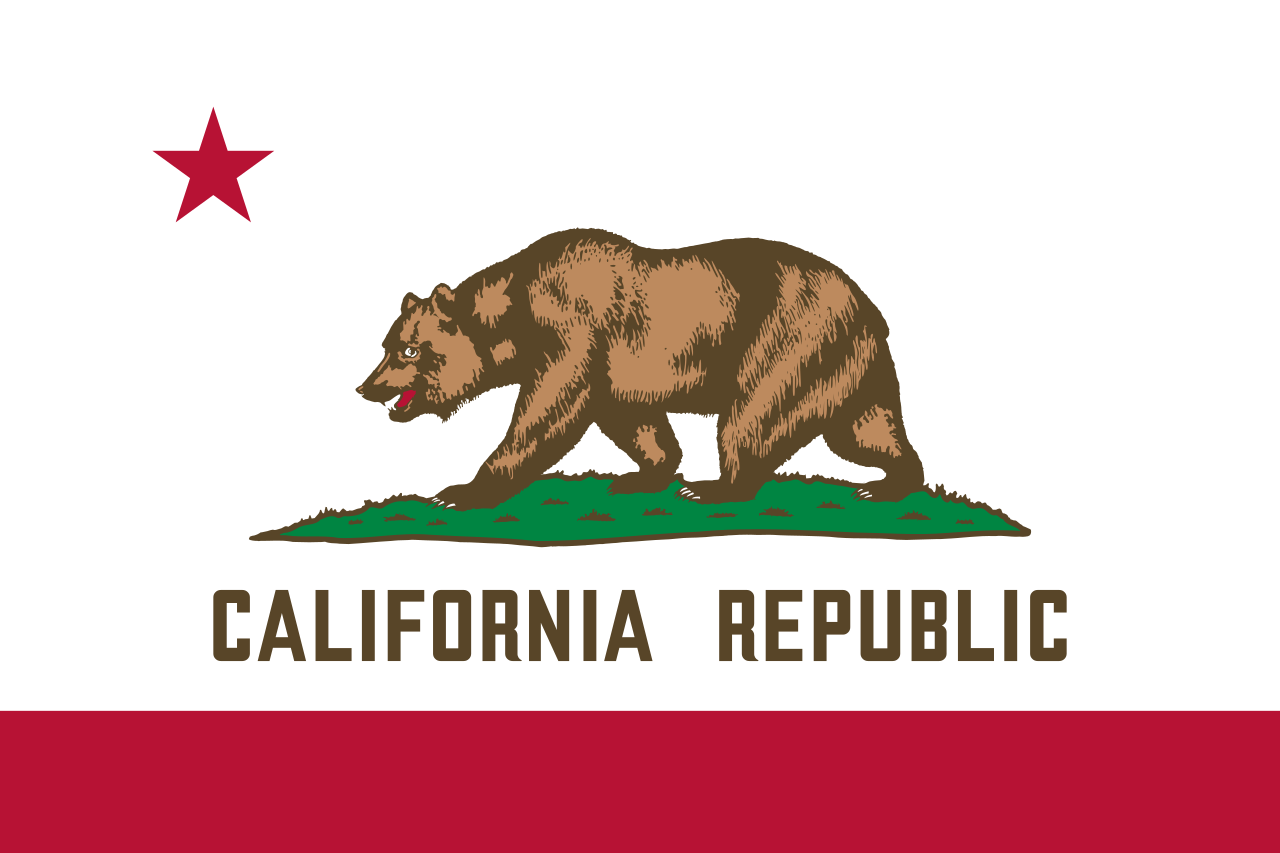 California-CA
California-CA
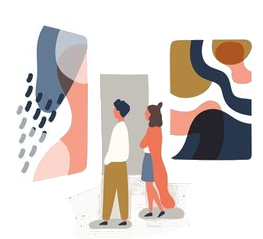 Exhibition
Exhibition
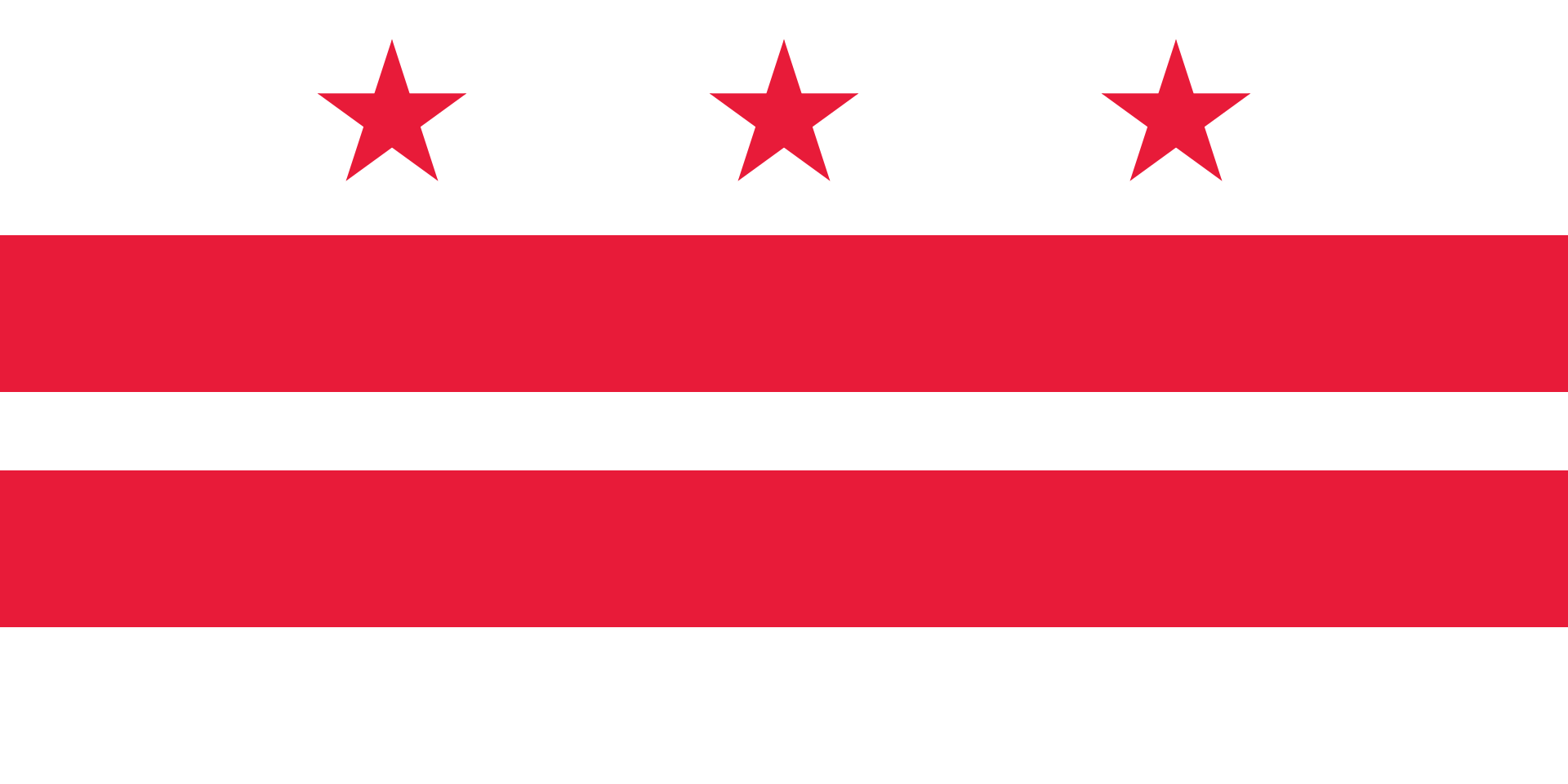 Washington, D.C.
Washington, D.C.
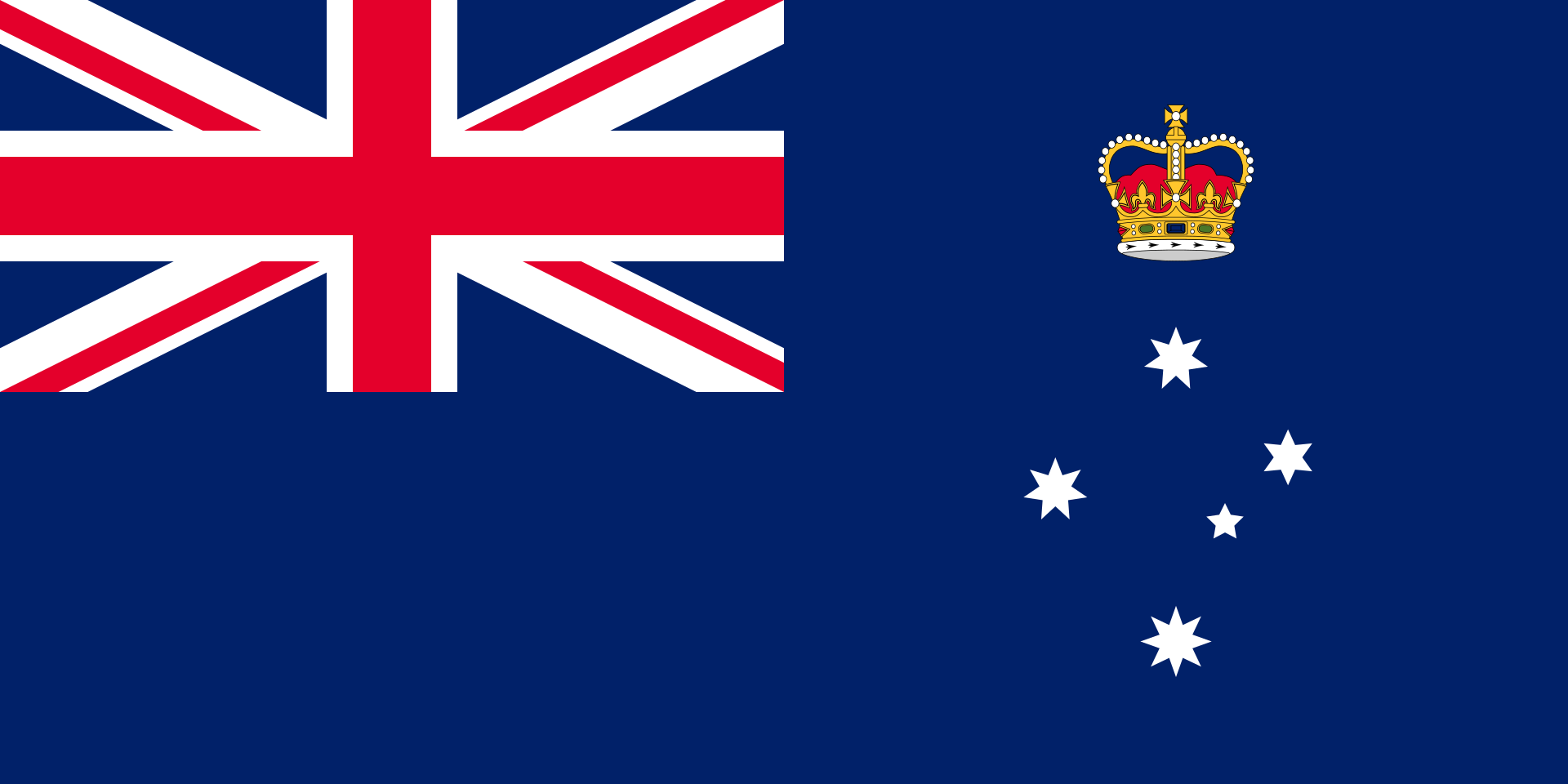 Victoria-VIC
Victoria-VIC
 Art
Art
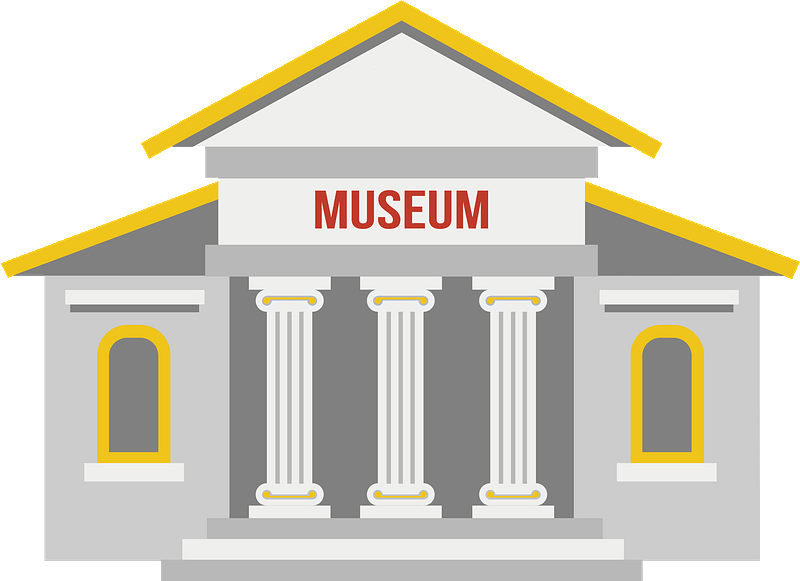 Museum
Museum
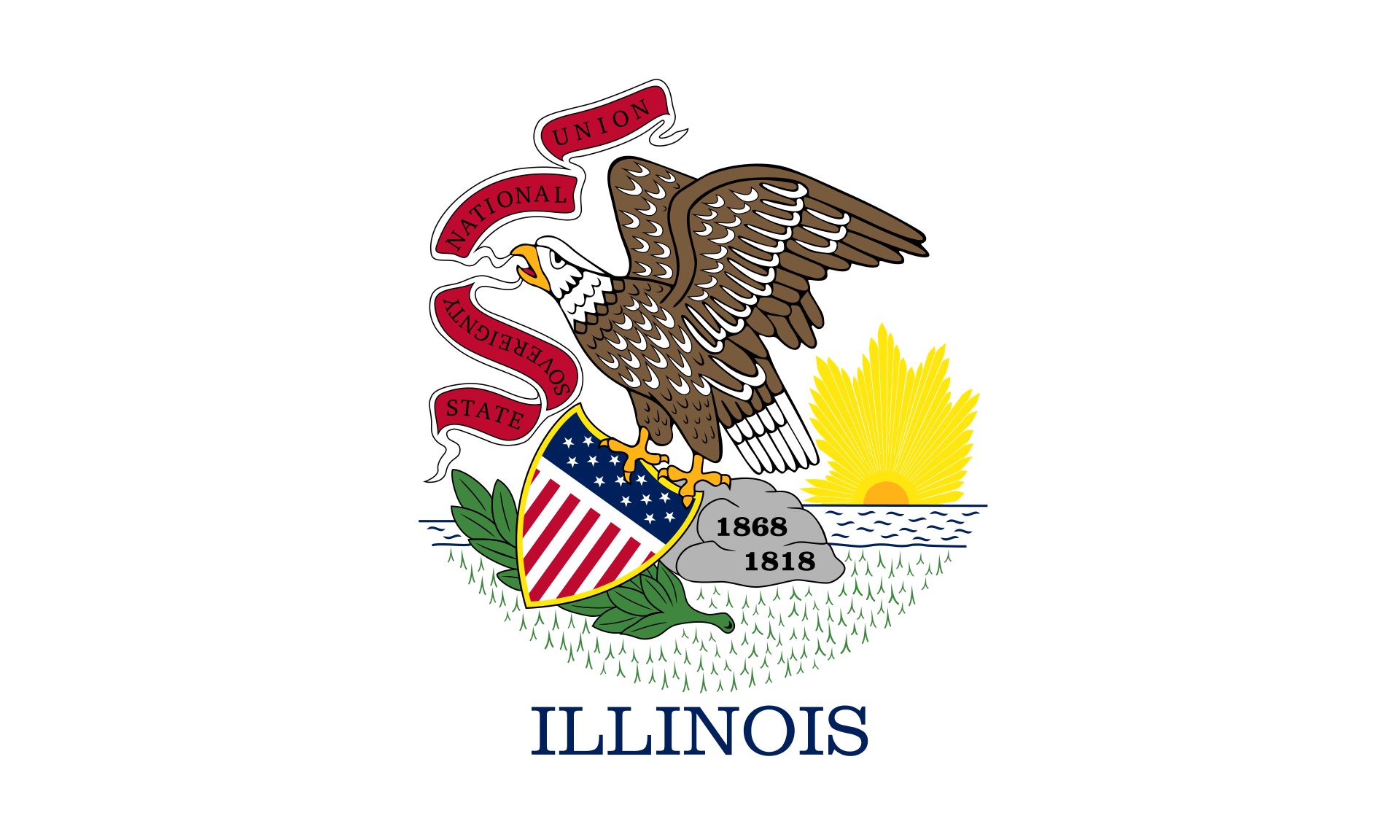 Illinois-IL
Illinois-IL
 Music
Music
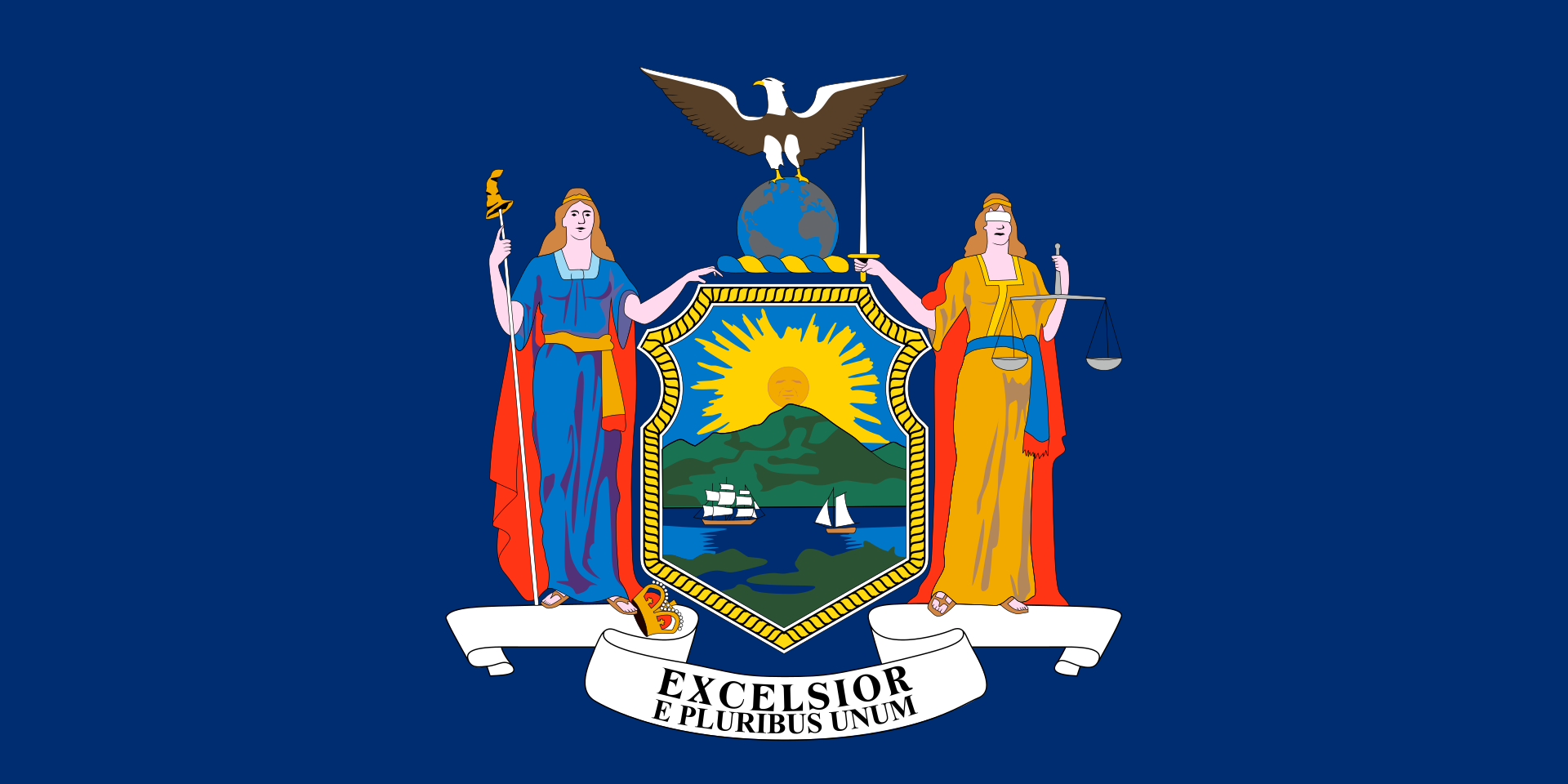 New York-NY
New York-NY